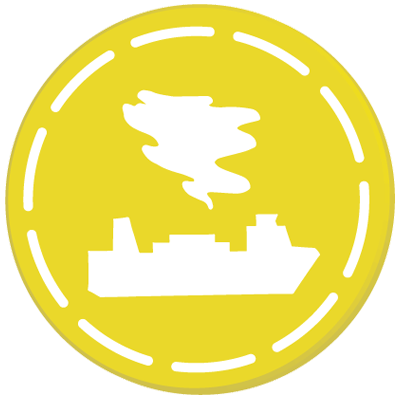SOP 2: Determination of the restriction area
PROCEDURES
2.1 First phase area isolation actions
In Hazardous and Noxious (HNS) incidents where there is a risk of flammable, explosive, toxic or irritative cloud or vapours, the dangerous area has to be isolated from maritime (and air) traffic. In general, only Search and Rescue Units (SRU) with the capability of entering the dangerous atmosphere are permitted to enter the restricted zone and only with Rescue Coordination Centre (RCC) approval.
2.2 Continuous risk assessment
Information to update a risk assessment and maintaining the situation awareness are essential when defining the restrictions to respond to the actual hazards on- scene. The continuous update process of the restriction and working areas should be based on the latest risk assessment and weather conditions (e.g. wind direction and weather forecast).
2.3 Assessment of the HNS impact
The restriction area for maritime and air traffic (NO-FLY zone; e.g. possible hazards, Remotely Piloted Aircraft System (RPAS) operations, rescue operations) should be determined based on information about the incident. Defining of area should be based on the information and identification of the HNS involved. The determination is done by formulating a circular (or hemisphere if there is a NO-FLY zone) area around the distressed vessel.
In a situation where information about the HNS involved is not available in the first phase, the radius of the immediate restriction area should be at least 2NM.
The effect of the weather and weather forecast as well as possible distressed vessel manoeuvres should be taken into account when determining the area for further restrictions. From the point of release, the gas cloud will move in the wind direction in a triangular area. The area defined from approximately a 30° angle from the release is the limit of the hot zone, and the 60° angle defines the warm zone limit. If there is a risk of the hazardous zone expanding to concern third parties (e.g. on land), continue procedures with the national land-based alarm plan.
2.2 Defining the restriction area
Risk assessment considering HNS in the area should be based on the support of the experts, predictive tools, databases, use of the cargo plan etc. available information. Additional information and situation reports (SITREP) from the distressed vessel (DV) (cargo information, hazards and alterations), rescue units on- scene and other maritime or air traffic will complete the situation awareness. RCC should continuously update the available HNS information.
The established area restrictions should be updated based on the performed risk assessment by increasing or reducing radius and formulating the shape of the restricted area. Definition of the area is done by means of measurements and by consulting experts for the drift estimations and calculations.
DV, SRUs, Vessel Traffic Service (VTS) (and Air Traffic Service (ATS) if needed) should be informed by the RCC considering the updates and possible cancellation of restrictions in the area.
2.3 Information
Maritime traffic should be regularly informed considering the restriction area with GMDSS PAN-PAN or MAYDAY RELAY messages. Contact VTS (and ATS) concerning the restriction of the areas. Contact relevant authorities and/ or media for the issuance of warnings, access restrictions and a general warning to people in the risk area, if needed.
SRUs approaching the area require the latest information on the restrictions and isolation process. The restriction area should be under the surveillance of authorities (RCC and SRUs with surveillance capability), and maritime traffic approaching the area should be informed and rerouted if necessary. The area restriction surveillance should be performed by authorities and vessels with the capacity to monitor the area’s isolation.
2.4 Determining areas for SAR operation
The three-level working zone system of area designation:
2.4.1 Hot zone
The hot zone is an area where the risk for contamination and probability for exposure to hazardous substances is highest. In the first phase, the hot zone can be the radius around the DV or a location on board the DV, based on HNS identification, measurements and calculations. The highest level of Personal Protective Equipment (PPE) is needed in this area.
2.4.2 Warm zone
The warm zone is an area surrounding the hot zone. This area is a transition area between the hot zone and the cold zone. The warm zone can be the radius around the DV or a location on board the DV, based on HNS identification, measurements and calculations. If a decontamination process is planned to proceed on board the SRU or other vessel on-scene, the vessel is usually positioned in the warm zone or on the border of the warm zone and cold zone, if possible. The warm zone and the cold zone are then established on board the SRU to ensure an effective decontamination process.
2.4.3 Cold zone
The cold zone is an area outside the warm zone. The cold zone is free from contamination and may be used as a holding and support area. When the warm zone and the cold zone are established on board the SRU, service and treatment facilities are located in the cold zone. The cold zone defines the outer safety cordon, i.e. the limit of the restricted area that should be under surveillance to prevent unauthorized entry.
2.4.4 Entry point
Prepare to arrange controlled access to the restricted area for the rescue vessels. Entering the warm zone should be upwind and allowed only for vessels with the capacity to perform rescue operations in the hazardous atmosphere. Weather and weather forecast (e.g. changes in wind direction) should be considered when establishing the entry (and exit) point of the restricted area.
